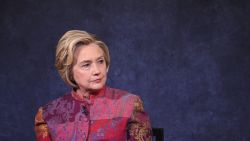Editor’s Note: Ruth Ben-Ghiat is a professor of history and Italian studies at New York University. Her latest book is “Italian Fascism’s Empire Cinema.” The opinions expressed in this commentary are solely those of the author.
Story highlights
Ruth Ben-Ghiat: Hillary Clinton calls out Trump in speech denouncing his providing platform for racist hate-speak
She says Clinton reached out to those in GOP repelled to have Trump "brand" linked to alt-right movement
Democratic presidential nominee Hillary Clinton came into her own Thursday in Reno. She spoke with righteous anger, painting her rival Donald Trump as a hate-monger beholden to white nationalist causes.
Her voice was firm, her body rooted and steady, her message freighted with urgency: This is a moment of reckoning for America. She combined civic education in her explanation of the alt-right movement, bipartisan outreach (appealing to Republicans by citing noble behavior of their past presidential nominees), and lawyerly dissection of the misguided reasons some conservatives continue to support Trump.
It ranks among her strongest speeches.
Why? Clinton depicted Trump as the rogue politician he is, one who qualitatively differs from all previous GOP nominees. Rogues (whether states or individuals) operate outside accepted norms or principles. This makes them seductive to some, even as they are a threat to most.
Trump positioned himself in this role from the very start. His first alt-right retweets sent a clear sign to disaffected white males: I will fix things, and I’ll do it outside, and against, the system. I’ll say, and show, what others are too cowardly to admit. I’ll make it safe for you to speak publicly, rather than in hushed tones at the local bar or gun show.
And so, from last fall onward, in the alt-right echo chamber online we had Hispanics depicted as border-crossing monkeys, and African-Americans as thugs; and we even had Trump himself casting women as disgusting, fluid-filled creatures; Jews as moneygrubbers.
Trump used Twitter as a focus group for his new brand: Trump, savior of white rights and white civilization. In one week in January 2016, 62% of Trump’s tweets had white nationalist origins or connections.
Trump campaign: 11 outrageous quotes
Twitter also became Trump’s virtual police force, on the hunt for any criticism of the leader and quick to strike. So many of us who have written about Trump have been harassed and threatened, especially if we seem to depart from the white Christian mold. I can tell you from the vitriol posted on my own feed that deportation trends right now, as opposed to cremation ovens a few months ago.
Is it any wonder David Duke, former head of the Ku Klux Klan, feels emboldened to run for office? Or that former UN Ambassador John Bolton, speaking on Fox News Thursday, feels free to say that people are being destructive if they identify as black or Hispanic?
This fringe, angling itself into the mainstream, courtesy of Trump, wants (nonwhite) race to just go quiet, and go away.
That’s why Clinton’s head-on confrontation with Trump’s racism in this speech is so necessary and powerful. She reminded us that Trump removed black dealers from his casinos; that federal investigators said he refused to rent to blacks and Hispanics; and that he provided, Clinton said, “a steady stream of bigotry” that has energized a segment of America that no longer recognized itself or its interests in the GOP.
Clinton demonstrated that Trump’s rogue identity depends on his embrace of conspiracy theories, many of them revolving around President Obama. By delegitimizing the current President on racial grounds, Trump builds up his own model of leadership, one built around loyalty to his person rather than a political party.
The tragedy of the GOP formed a subtheme of Clinton’s speech, and a subtext of her appeal to bipartisan voters.
She evoked a Republican Party that might seem quaint and unfamiliar to those whose introduction to politics has been this unusual election campaign. She recalled Sen. Bob Dole asking racists to leave the room as he accepted the presidential nomination in 1996; Sen. John McCain, reining in, rather than inciting racism, against Obama in the course of his failed 2008 presidential campaign.
Clinton did not have to add that both these men now endorse Trump to make clear how far the GOP has fallen. “I will be a President for all Americans,” she said, meaning disillusioned conservatives as well as people of all ages, races and genders.
This inclusiveness, which has shaped this electoral season as the Democrats’ national hook, is Clinton’s strongest suit. It’s a hedge against Trump’s divisiveness and doomsday scenarios, but also an opportunity for her to demonstrate her compassion and further humanize herself to voters. Perhaps her best moment in this regard was when she expressed sadness that Trump was missing so much by focusing on black communities in purely a negative vein.
As I watched Clinton’s speech on YouTube, I also scanned an adjacent feed that quickly became a blur of racial slurs and insults. The contrast between the sentiments expressed on the two halves of my computer screen was striking.
Millions of Americans know this river of hate all too well: They swim in it. Others have been reluctant to acknowledge how great Trump’s influence has been in this regard. Clinton showed leadership in addressing it head-on in Reno. Other political leaders, from both parties, should follow.

































